2010 FIFA World Cup facts for kids
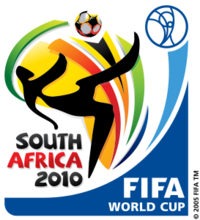
Ke nako (Setswana and Sesotho)
It's time. Celebrate Africa's Humanity (English) Dis tyd. Vier Afrika se mensdom (Afrikaans) Isikhathi. Gubha Ubuntu Base-Afrika (Zulu) Lixesha. Ukubhiyozela Ubuntu baseAfrika (Xhosa) Inguva. Kupemberera hupenyu hweAfrica (Shona) Ke nako. Keteka Botho ba Afrika (Southern Sotho) |
|
| Tournament details | |
|---|---|
| Host country | South Africa |
| Dates | 11 June – 11 July |
| Teams | 32 (from 6 confederations) |
| Venue(s) | 10 (in 9 host cities) |
| Final positions | |
| Champions | |
| Runners-up | |
| Third place | |
| Fourth place | |
| Tournament statistics | |
| Matches played | 64 |
| Goals scored | 145 (2.27 per match) |
| Attendance | 3,178,856 (49,670 per match) |
| Top scorer(s) | (5 goals each) |
| Best player | |
| Best young player | |
| Best goalkeeper | |
| Fair play award | |

The 2010 FIFA World Cup was the 19th FIFA World Cup, the world championship for men's national football teams. It took place in South Africa from 11 June to 11 July 2010. The bidding process for hosting the tournament finals was open only to African nations. In 2004, the international football federation, FIFA, selected South Africa over Egypt and Morocco to become the first African nation to host the finals.
The matches were played in 10 stadiums in nine host cities around the country, with the opening and final played at the Soccer City stadium in South Africa's largest city, Johannesburg. Thirty-two teams were selected for participation via a worldwide qualification tournament that began in August 2007. In the first round of the tournament finals, the teams competed in round-robin groups of four teams for points, with the top two teams in each group proceeding. These 16 teams advanced to the knockout stage, where three rounds of play decided which teams would participate in the final.
In the final, Spain, the European champions, beat third-time losing finalists the Netherlands 1–0 after extra time to win their first world title. Spain became the eighth nation to win the tournament and the first European nation to win a World Cup hosted outside its home continent: all previous World Cups held outside Europe had been won by South American nations. They are also the first national team since 1978 to win a World Cup after losing a game in the group stage. As a result of their win, Spain represented the World in the 2013 FIFA Confederations Cup. Host nation South Africa were eliminated in the group stage, as were both 2006 World Cup finalists, Italy and France. It was the first time that the hosts had been eliminated in the first stage. New Zealand, with their three draws, were the only undefeated team in the tournament, but they were also eliminated in the group stage.
Venues
In 2005, the organisers released a provisional list of 13 venues to be used for the World Cup: Bloemfontein, Cape Town, Durban, Johannesburg (two venues), Kimberley, Klerksdorp, Nelspruit, Orkney, Polokwane, Port Elizabeth, Pretoria, and Rustenburg. This was narrowed down to the ten venues that were officially announced by FIFA on 17 March 2006.
The altitude of several venues affected the motion of the ball and player performance, although FIFA's medical chief downplayed this consideration. Six of the ten venues were over 1,200 m (3,900 ft) above sea level, with the two Johannesburg venues—FNB Stadium (also known as Soccer City) and Ellis Park Stadium—the highest at approximately 1,750 m (5,740 ft).
FNB Stadium, Cape Town Stadium, and Nelson Mandela Bay Stadium in Port Elizabeth were the most-used venues, each hosting eight matches. Ellis Park Stadium and Moses Mabhida Stadium in Durban hosted seven matches each, while Loftus Versfeld Stadium in Pretoria, Free State Stadium in Bloemfontein and Royal Bafokeng Stadium in Rustenburg hosted six matches each. Peter Mokaba Stadium in Polokwane and Mbombela Stadium in Nelspruit hosted four matches each, but did not host any knockout-stage matches.
| Johannesburg | Cape Town | Durban | |
|---|---|---|---|
| FNB Stadium (Soccer City) |
Ellis Park Stadium | Cape Town Stadium (Green Point Stadium) |
Moses Mabhida Stadium (Durban Stadium) |
| 26°14′5.27″S 27°58′56.47″E / 26.2347972°S 27.9823528°E | 26°11′51.07″S 28°3′38.76″E / 26.1975194°S 28.0607667°E | 33°54′12.46″S 18°24′40.15″E / 33.9034611°S 18.4111528°E | 29°49′46″S 31°01′49″E / 29.82944°S 31.03028°E |
| Capacity: 84,490 | Capacity: 55,686 | Capacity: 64,100 | Capacity: 62,760 |
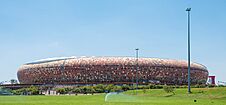 |
 |
 |
 |
| Pretoria | |||
| Loftus Versfeld Stadium | |||
| 25°45′12″S 28°13′22″E / 25.75333°S 28.22278°E | |||
| Capacity: 42,858 | |||
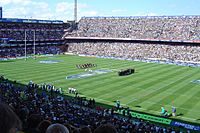 |
|||
| Port Elizabeth | Stadiums in Johannesburg | ||
| Nelson Mandela Bay Stadium | |||
| 33°56′16″S 25°35′56″E / 33.93778°S 25.59889°E | |||
| Capacity: 42,486 | |||
 |
|||
| Rustenburg | Polokwane | Nelspruit | Bloemfontein |
| 25°34′43″S 27°09′39″E / 25.5786°S 27.1607°E | 23°55′29″S 29°28′08″E / 23.924689°S 29.468765°E | 25°27′42″S 30°55′47″E / 25.46172°S 30.929689°E | 29°07′02.25″S 26°12′31.85″E / 29.1172917°S 26.2088472°E |
| Royal Bafokeng Stadium | Peter Mokaba Stadium | Mbombela Stadium | Free State Stadium |
| Capacity: 42,000 | Capacity: 41,733 | Capacity: 40,929 | Capacity: 40,911 |
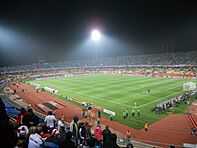 |
 |
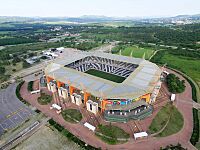 |
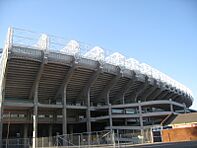 |
The following stadiums were all upgraded to meet FIFA specifications:
|
|
|
Referees
FIFA's Referees' Committee selected 29 referees through its Refereeing Assistance Programme to officiate at the World Cup: four from the AFC, three from the CAF, six from CONMEBOL, four from CONCACAF, two from the OFC, and ten from UEFA. English referee Howard Webb was chosen to referee the final, making him the first person to referee both the UEFA Champions League final and the World Cup final in the same year.
Squads
As with the 2006 tournament, each team's squad for the 2010 World Cup consisted of 23 players. Each participating national association had to confirm their final 23-player squad by 1 June 2010. Teams were permitted to make late replacements in the event of serious injury, at any time up to 24 hours before their first game.
Of the 736 players participating in the tournament, over half played their club football in five European domestic leagues; those in England (117 players), Germany (84), Italy (80), Spain (59) and France (46). The English, German and Italian squads were made up of entirely home based players, while only Nigeria had no players from clubs in their own league. In all, players from 52 national leagues entered the tournament. FC Barcelona of Spain was the club contributing the most players to the tournament, with 13 players of their side travelling, 7 with the Spanish team, while another 7 clubs contributed 10 players or more.
In another first for South Africa 2010, one squad included three siblings. Jerry, Johnny, and Wilson Palacios made history thanks to their inclusion in Honduras's 23-man list. Unusually, the game between Germany and Ghana had two brothers playing for opposite nations, with Jérôme Boateng and Kevin-Prince Boateng playing respectively.
Match summary
The 32 national teams involved in the tournament together played a total of 64 matches starting from the group stage matches and progressing to the knockout stage matches, with teams eliminated through the various progressive stages. Rest days were allocated during the various stages to allow players recovery during the tournament. Preliminary events were also held in celebration of the World Cup event. All times listed in the table below are in South African Standard Time (UTC+02).
| Day | Time | Venue | Stage | Team 1 | Result | Team 2 | |
|---|---|---|---|---|---|---|---|
| Thursday 10 June |
Preliminary events | ||||||
| 20:00 | Soweto | FIFA Kick-off Celebration Concert | |||||
| Friday 11 June |
14:00 | Johannesburg (SC) | Opening ceremony | ||||
| First round of group stage matches | |||||||
| 16:00 | Johannesburg (SC) | Group A | South Africa |
1–1 | |||
| 20:30 | Cape Town | Uruguay |
0–0 | ||||
| Saturday 12 June |
13:30 | Port Elizabeth | Group B | South Korea |
2–0 | ||
| 16:00 | Johannesburg (EP) | Argentina |
1–0 | ||||
| 20:30 | Rustenburg | Group C | England |
1–1 | |||
| Sunday 13 June |
13:30 | Polokwane | Algeria |
0–1 | |||
| 16:00 | Pretoria | Group D | Serbia |
0–1 | |||
| 20:30 | Durban | Germany |
4–0 | ||||
| Monday 14 June |
13:30 | Johannesburg (SC) | Group E | Netherlands |
2–0 | ||
| 16:00 | Bloemfontein | Japan |
1–0 | ||||
| 20:30 | Cape Town | Group F | Italy |
1–1 | |||
| Tuesday 15 June |
13:30 | Rustenburg | New Zealand |
1–1 | |||
| 16:00 | Port Elizabeth | Group G | Ivory Coast |
0–0 | |||
| 20:30 | Johannesburg (EP) | Brazil |
2–1 | ||||
| Wednesday 16 June |
13:30 | Nelspruit | Group H | Honduras |
0–1 | ||
| 16:00 | Durban | Spain |
0–1 | ||||
| Second round of group stage matches | |||||||
| 20:30 | Pretoria | Group A | South Africa |
0–3 | |||
| Thursday 17 June |
13:30 | Johannesburg (SC) | Group B | Argentina |
4–1 | ||
| 16:00 | Bloemfontein | Greece |
2–1 | ||||
| 20:30 | Polokwane | Group A | France |
0–2 | |||
| Friday 18 June |
13:30 | Port Elizabeth | Group D | Germany |
0–1 | ||
| 16:00 | Johannesburg (EP) | Group C | Slovenia |
2–2 | |||
| 20:30 | Cape Town | England |
0–0 | ||||
| Saturday 19 June |
13:30 | Durban | Group E | Netherlands |
1–0 | ||
| 16:00 | Rustenburg | Group D | Ghana |
1–1 | |||
| 20:30 | Pretoria | Group E | Cameroon |
1–2 | |||
| Sunday 20 June |
13:30 | Bloemfontein | Group F | Slovakia |
0–2 | ||
| 16:00 | Nelspruit | Italy |
1–1 | ||||
| 20:30 | Johannesburg (SC) | Group G | Brazil |
3–1 | |||
| Monday 21 June |
13:30 | Cape Town | Portugal |
7–0 | |||
| 16:00 | Port Elizabeth | Group H | Chile |
1–0 | |||
| 20:30 | Johannesburg (EP) | Spain |
2–0 | ||||
| Tuesday 22 June |
Third round of group stage matches | ||||||
| 16:00 | Rustenburg | Group A | Mexico |
0–1 | |||
| Bloemfontein | France |
1–2 | |||||
| 20:30 | Durban | Group B | Nigeria |
2–2 | |||
| Polokwane | Greece |
0–2 | |||||
| Wednesday 23 June |
16:00 | Port Elizabeth | Group C | Slovenia |
0–1 | ||
| Pretoria | United States |
1–0 | |||||
| 20:30 | Johannesburg (SC) | Group D | Ghana |
0–1 | |||
| Nelspruit | Australia |
2–1 | |||||
| Thursday 24 June |
16:00 | Johannesburg (EP) | Group F | Slovakia |
3–2 | ||
| Polokwane | Paraguay |
0–0 | |||||
| 20:30 | Rustenburg | Group E | Denmark |
1–3 | |||
| Cape Town | Cameroon |
1–2 | |||||
| Friday 25 June |
16:00 | Durban | Group G | Portugal |
0–0 | ||
| Nelspruit | North Korea |
0–3 | |||||
| 20:30 | Pretoria | Group H | Chile |
1–2 | |||
| Bloemfontein | Switzerland |
0–0 | |||||
| Saturday 26 June |
Knockout stage matches | ||||||
| 16:00 | Port Elizabeth | Round of 16 | Uruguay |
2–1 | |||
| 20:30 | Rustenburg | United States |
1–2 (aet) | ||||
| Sunday 27 June |
16:00 | Bloemfontein | Germany |
4–1 | |||
| 20:30 | Johannesburg (SC) | Argentina |
3–1 | ||||
| Monday 28 June |
16:00 | Durban | Netherlands |
2–1 | |||
| 20:30 | Johannesburg (EP) | Brazil |
3–0 | ||||
| Tuesday 29 June |
16:00 | Pretoria | Paraguay |
0–0 (aet) (5–3 p) |
|||
| 20:30 | Cape Town | Spain |
1–0 | ||||
| Wednesday 30 June |
Rest days | ||||||
| Thursday 1 July |
|||||||
| Friday 2 July |
16:00 | Port Elizabeth | Quarter-finals | Netherlands |
2–1 | ||
| 20:30 | Johannesburg (SC) | Uruguay |
1–1 (aet) (4–2 p) |
||||
| Saturday 3 July |
16:00 | Cape Town | Argentina |
0–4 | |||
| 20:30 | Johannesburg (EP) | Paraguay |
0–1 | ||||
| Sunday 4 July |
Rest days | ||||||
| Monday 5 July |
|||||||
| Tuesday 6 July |
20:30 | Cape Town | Semi-finals | Uruguay |
2–3 | ||
| Wednesday 7 July |
Durban | Germany |
0–1 | ||||
| Thursday 8 July |
Rest days | ||||||
| Friday 9 July |
|||||||
| Saturday 10 July |
20:30 | Port Elizabeth | Third place match |
Uruguay |
2–3 | ||
| Sunday 11 July |
18:30 | Johannesburg (SC) | Closing ceremony | ||||
| 20:30 | Final | Netherlands |
0–1 (aet) | ||||
Statistics
Goalscorers
South African winger Siphiwe Tshabalala was the first player to score a goal in the competition, in their 1–1 draw against Mexico, the opening game of the tournament. Danish defender Daniel Agger was credited with the first own goal of the tournament, in his side's 2–0 loss to the Netherlands. Argentine striker Gonzalo Higuaín was the only player to score a hat-trick in the tournament, in Argentina's 4–1 win over South Korea, the match where the second and last own goal was scored. It was the 49th World Cup hat-trick in the history of the tournament.
Spain set a new record for the fewest goals scored by a World Cup-winning team, with eight. The previous record low was 11, set by Brazil in 1994, England in 1966, and Italy in 1938. Spain had the fewest goalscorers for a champion as well (three – Villa with five goals, Iniesta with two and Puyol with one). They also had the fewest goals conceded for a champion (2), equal with Italy (2006) and France (1998). Spain's victory marked the first time that a team won the World Cup without conceding a goal in the knockout stage.
The four top scorers in the tournament had five goals each. All of the four top scorers also came from the teams that finished in the top four, Spain, the Netherlands, Germany, and Uruguay. The Golden Boot went to Thomas Müller of Germany who had three assists, compared to one for the three others. The Silver Boot went to David Villa of Spain, who played a total of 635 minutes, and the Bronze Boot to Wesley Sneijder of the Netherlands, who played 652 minutes. Diego Forlán of Uruguay had five goals and one assist in 654 minutes. A further three players scored four goals.
Only 145 goals were scored at South Africa 2010, the lowest of any FIFA World Cup since the tournament switched to a 64-game format. This continued a downward trend since the first 64-game finals were held 12 years earlier, with 171 goals at France 1998, 161 at Korea/Japan 2002 and 147 at Germany 2006.
5 goals
4 goals
 Gonzalo Higuaín
Gonzalo Higuaín Miroslav Klose
Miroslav Klose Róbert Vittek
Róbert Vittek
3 goals
2 goals
 Carlos Tevez
Carlos Tevez Brett Holman
Brett Holman Elano
Elano Robinho
Robinho Samuel Eto'o
Samuel Eto'o Lukas Podolski
Lukas Podolski Keisuke Honda
Keisuke Honda Javier Hernández
Javier Hernández Arjen Robben
Arjen Robben Kalu Uche
Kalu Uche Tiago
Tiago Lee Chung-yong
Lee Chung-yong Lee Jung-soo
Lee Jung-soo Andrés Iniesta
Andrés Iniesta
1 goal
 Martín Demichelis
Martín Demichelis Gabriel Heinze
Gabriel Heinze Martín Palermo
Martín Palermo Tim Cahill
Tim Cahill Juan
Juan Maicon
Maicon Jean Beausejour
Jean Beausejour Mark González
Mark González Rodrigo Millar
Rodrigo Millar Nicklas Bendtner
Nicklas Bendtner Dennis Rommedahl
Dennis Rommedahl Jon Dahl Tomasson
Jon Dahl Tomasson Jermain Defoe
Jermain Defoe Steven Gerrard
Steven Gerrard Matthew Upson
Matthew Upson Florent Malouda
Florent Malouda Cacau
Cacau Arne Friedrich
Arne Friedrich Marcell Jansen
Marcell Jansen Sami Khedira
Sami Khedira Mesut Özil
Mesut Özil Kevin-Prince Boateng
Kevin-Prince Boateng Sulley Muntari
Sulley Muntari Dimitris Salpingidis
Dimitris Salpingidis Vasilis Torosidis
Vasilis Torosidis Daniele De Rossi
Daniele De Rossi Antonio Di Natale
Antonio Di Natale Vincenzo Iaquinta
Vincenzo Iaquinta Fabio Quagliarella
Fabio Quagliarella Didier Drogba
Didier Drogba Salomon Kalou
Salomon Kalou Romaric
Romaric Yaya Touré
Yaya Touré Yasuhito Endō
Yasuhito Endō Shinji Okazaki
Shinji Okazaki Cuauhtémoc Blanco
Cuauhtémoc Blanco Rafael Márquez
Rafael Márquez Klaas-Jan Huntelaar
Klaas-Jan Huntelaar Dirk Kuyt
Dirk Kuyt Giovanni van Bronckhorst
Giovanni van Bronckhorst Robin van Persie
Robin van Persie Winston Reid
Winston Reid Shane Smeltz
Shane Smeltz Yakubu
Yakubu Ji Yun-nam
Ji Yun-nam Antolín Alcaraz
Antolín Alcaraz Cristian Riveros
Cristian Riveros Enrique Vera
Enrique Vera Hugo Almeida
Hugo Almeida Cristiano Ronaldo
Cristiano Ronaldo Liédson
Liédson Raul Meireles
Raul Meireles Simão
Simão Milan Jovanović
Milan Jovanović Marko Pantelić
Marko Pantelić Kamil Kopúnek
Kamil Kopúnek Valter Birsa
Valter Birsa Robert Koren
Robert Koren Zlatan Ljubijankić
Zlatan Ljubijankić Bongani Khumalo
Bongani Khumalo Katlego Mphela
Katlego Mphela Siphiwe Tshabalala
Siphiwe Tshabalala Park Chu-young
Park Chu-young Park Ji-sung
Park Ji-sung Carles Puyol
Carles Puyol Gelson Fernandes
Gelson Fernandes Michael Bradley
Michael Bradley Clint Dempsey
Clint Dempsey Edinson Cavani
Edinson Cavani Álvaro Pereira
Álvaro Pereira Maxi Pereira
Maxi Pereira
1 own goal
 Daniel Agger (against Netherlands)
Daniel Agger (against Netherlands) Park Chu-young (against Argentina)
Park Chu-young (against Argentina)
Discipline
28 players were suspended after being shown two consecutive yellow cards (13 players), a single red card (8 players), or a yellow card followed by a red card (7 players).
Final standings
Shortly after the final, FIFA issued a final ranking of every team in the tournament. The ranking was based on progress in the competition, overall results and quality of the opposition. All 32 teams are ranked based on criteria which have been used by FIFA. The final ranking was as follows:
| R | Team | G | Pld | W | D | L | GF | GA | GD | Pts. |
|---|---|---|---|---|---|---|---|---|---|---|
| 1 | H | 7 | 6 | 0 | 1 | 8 | 2 | +6 | 18 | |
| 2 | E | 7 | 6 | 0 | 1 | 12 | 6 | +6 | 18 | |
| 3 | D | 7 | 5 | 0 | 2 | 16 | 5 | +11 | 15 | |
| 4 | A | 7 | 3 | 2 | 2 | 11 | 8 | +3 | 11 | |
| Eliminated in the quarter-finals | ||||||||||
| 5 | B | 5 | 4 | 0 | 1 | 10 | 6 | +4 | 12 | |
| 6 | G | 5 | 3 | 1 | 1 | 9 | 4 | +5 | 10 | |
| 7 | D | 5 | 2 | 2 | 1 | 5 | 4 | +1 | 8 | |
| 8 | F | 5 | 1 | 3 | 1 | 3 | 2 | +1 | 6 | |
| Eliminated in the round of 16 | ||||||||||
| 9 | E | 4 | 2 | 1 | 1 | 4 | 2 | +2 | 7 | |
| 10 | H | 4 | 2 | 0 | 2 | 3 | 5 | −2 | 6 | |
| 11 | G | 4 | 1 | 2 | 1 | 7 | 1 | +6 | 5 | |
| 12 | C | 4 | 1 | 2 | 1 | 5 | 5 | 0 | 5 | |
| 13 | C | 4 | 1 | 2 | 1 | 3 | 5 | −2 | 5 | |
| 14 | A | 4 | 1 | 1 | 2 | 4 | 5 | −1 | 4 | |
| 15 | B | 4 | 1 | 1 | 2 | 6 | 8 | −2 | 4 | |
| 16 | F | 4 | 1 | 1 | 2 | 5 | 7 | −2 | 4 | |
| Eliminated in the group stage | ||||||||||
| 17 | G | 3 | 1 | 1 | 1 | 4 | 3 | +1 | 4 | |
| 18 | C | 3 | 1 | 1 | 1 | 3 | 3 | 0 | 4 | |
| 19 | H | 3 | 1 | 1 | 1 | 1 | 1 | 0 | 4 | |
| 20 | A | 3 | 1 | 1 | 1 | 3 | 5 | −2 | 4 | |
| 21 | D | 3 | 1 | 1 | 1 | 3 | 6 | −3 | 4 | |
| 22 | F | 3 | 0 | 3 | 0 | 2 | 2 | 0 | 3 | |
| 23 | D | 3 | 1 | 0 | 2 | 2 | 3 | −1 | 3 | |
| 24 | E | 3 | 1 | 0 | 2 | 3 | 6 | −3 | 3 | |
| 25 | B | 3 | 1 | 0 | 2 | 2 | 5 | −3 | 3 | |
| 26 | F | 3 | 0 | 2 | 1 | 4 | 5 | −1 | 2 | |
| 27 | B | 3 | 0 | 1 | 2 | 3 | 5 | −2 | 1 | |
| 28 | C | 3 | 0 | 1 | 2 | 0 | 2 | −2 | 1 | |
| 29 | A | 3 | 0 | 1 | 2 | 1 | 4 | −3 | 1 | |
| 30 | H | 3 | 0 | 1 | 2 | 0 | 3 | −3 | 1 | |
| 31 | E | 3 | 0 | 0 | 3 | 2 | 5 | −3 | 0 | |
| 32 | G | 3 | 0 | 0 | 3 | 1 | 12 | −11 | 0 | |
Awards
Main awards
| # | Player | Votes |
|---|---|---|
| 1st | 23.4% | |
| 2nd | 21.8% | |
| 3rd | 16.9% |
- Golden Boot:
 Thomas Müller
Thomas Müller - Golden Glove:
 Iker Casillas
Iker Casillas - Best Young Player:
 Thomas Müller
Thomas Müller - FIFA Fair Play Trophy:
 Spain
Spain
All-Star Team
FIFA released an All-Star Team based on the Castrol performance index in its official website.
| Goalkeeper | Defenders | Midfielders | Forwards |
|---|---|---|---|
|
|
Dream Team
For the first time, FIFA published a Dream Team decided by an online public vote. People were invited to select a team (in a 4–4–2 formation) and best coach; voting was open until 23:59 on 11 July 2010, with entrants going into a draw to win a prize.
Six of the eleven players came from the Spanish team, as did the coach. The remainder of the team comprised two players from Germany, and one each from Brazil, the Netherlands and Uruguay.
| Goalkeeper | Defenders | Midfielders | Forwards |
|---|---|---|---|
|
|
Marketing

Sponsorship
The sponsors of the 2010 World Cup are divided into three categories: FIFA Partners, FIFA World Cup Sponsors and National Supporters.
| FIFA partners | FIFA World Cup sponsors | National supporters | ||
|---|---|---|---|---|
|
|
Vuvuzelas
The 2010 finals amplified international public awareness of the vuvuzela, a long horn blown by fans throughout matches. Many World Cup competitors complained about the noise caused by the vuvuzela horns, including France's Patrice Evra, who blamed the horns for the team's poor performance. Other critics include Lionel Messi, who complained that the sound of the vuvuzelas hampered communication among players on the pitch, and broadcasting companies, which complained that commentators' voices were drowned out by the sound.
Others watching on television complained that the ambient audio feed from the stadium contained only the sounds of the vuvuzelas with the usual sounds of people in the stands drowned out. A spokesperson for ESPN and other networks said that they were taking steps to minimise the ambient noise on their broadcasts. The BBC also investigated the possibility of offering broadcasts without vuvuzela noise.
Symbols
Mascot
The official mascot for the 2010 World Cup was Zakumi, an anthropomorphised African leopard with green hair, presented on 22 September 2008. His name came from "ZA" (the international abbreviation for South Africa) and the term kumi, which means "ten" in various African languages. The mascot's colours reflected those of the host nation's playing strip – yellow and green.
Match ball
The match ball for the 2010 World Cup, manufactured by Adidas, was named the Jabulani, which means "bringing joy to everyone" in Zulu. It was the 11th World Cup match ball made by the German sports equipment maker; it featured 11 colours, representing each player of a team on the pitch and the 11 official languages of South Africa. A special match ball with gold panels, called the Jo'bulani, was used at the final in Johannesburg.
The ball was constructed using a new design, consisting of eight thermally bonded, three-dimensional panels. These were spherically moulded from ethylene-vinyl acetate (EVA) and thermoplastic polyurethanes (TPU). The surface of the ball was textured with grooves, a technology developed by Adidas called GripnGroove that was intended to improve the ball's aerodynamics. The design received considerable academic input, being developed in partnership with researchers from Loughborough University, United Kingdom. The balls were made in China, using latex bladders made in India, thermoplastic polyurethane-elastomer from Taiwan, ethylene vinyl acetate, isotropic polyester/cotton fabric, and glue and ink from China.
Some football stars complained about the new ball, arguing that its movements were difficult to predict. Brazilian goalkeeper Júlio César compared it to a "supermarket" ball that favored strikers and worked against goalkeepers. Argentinian coach Diego Maradona said: "We won't see any long passes in this World Cup because the ball doesn't fly straight." However, a number of Adidas-sponsored players responded favourably to the ball.
Music
The official song of the 2010 World Cup "Waka Waka (This Time for Africa)", was performed by the Colombian singer Shakira and the band Freshlyground from South Africa, and is sung in both English and Spanish. The song is based on a traditional African soldiers' song, "Zangalewa". Shakira and Freshlyground performed the song at the pre-tournament concert in Soweto on 10 June. It was also sung at the opening ceremony on 11 June and at the closing ceremony on 11 July.
The official mascot song of the 2010 World Cup was "Game On".
The official anthem of the 2010 World Cup was "Sign of a Victory" by R. Kelly with the Soweto Spiritual Singers, which was also performed at the opening ceremony.
Media
Broadcasting
The 2010 FIFA World Cup was expected to be the most-watched television event in history. Hundreds of broadcasters, representing about 70 countries, transmitted the Cup to a TV audience that FIFA officials expect to exceed a cumulative 26 billion people, an average of approximately 400 million viewers per match. FIFA estimated that around 700 million viewers would watch the World Cup final.
New forms of digital media have also allowed viewers to watch coverage through alternative means. "With games airing live on cell phones and computers, the World Cup will get more online coverage than any major sporting event yet," said Jake Coyle of the Associated Press.
In the United States, ABC, ESPN, and ESPN2 averaged a 2.1 rating, 2,288,000 households and 3,261,000 viewers for the 64 World Cup games. The rating was up 31 percent from a 1.6 in 2006, while households increased 32 percent from 1,735,000 and viewers rose from 2,316,000. The increases had been higher while the US remained in the tournament. Through the first 50 games, the rating was up 48 percent, households increased 54 percent and viewers rose 60 percent. Univision averaged 2,624,000 viewers for the tournament, up 17 percent, and 1,625,000 households, an increase of 11 percent. An executive of the Nielsen Company, a leading audience research firm in the US, described the aggregate numbers for both networks' coverage of the match between the United States and Ghana as "phenomenal". Live World Cup streaming on ESPN3.com pulled in some of the largest audiences in history, as 7.4 million unique viewers tuned in for matches. In total, ESPN3.com generated 942 million minutes of viewing or more than two hours per unique viewer. All 64 live matches were viewed by an average of 114,000 persons per minute. Most impressive were the numbers for the semi-final between Spain and Germany, which was viewed by 355,000 people per minute, making it ESPN3.com's largest average audience ever.
Filming
Sony technology was used to film the tournament. 25 of the matches were captured using 3D cameras. Footage was captured in 3D through Sony's proprietary multi-image MPE-200 processors, housed in specially designed 3D outside broadcast trucks. It supplied its flagship HDC-1500 cameras as well as its new HDC-P1 unit, a compact, point-of-view (POV)-type camera with 3, 2/3-inch CCD sensors. The 3D games were produced for FIFA by Host Broadcast Services.
Video games
In PlayStation Home, Sony released a virtual space based on the 2010 FIFA World Cup in the Japanese version of Home on 3 December 2009. This virtual space is called the "FevaArena" and is a virtual stadium of the 2010 FIFA World Cup, featuring different areas for events, a FIFA mini-game, and a shop with FIFA related content.
On 27 April 2010, EA Sports released the official 2010 World Cup video game.
FIFA Fan Fest
FIFA expanded the FIFA Fan Fest, hosting in Sydney, Buenos Aires, Berlin, Paris, Rome, Rio de Janeiro, and Mexico City, as well as several venues around South Africa. The Durban Fan Fest was the most popular in South Africa during the tournament followed by the Cape Town Fan Fest.
See also
 In Spanish: Copa Mundial de Fútbol de 2010 para niños
In Spanish: Copa Mundial de Fútbol de 2010 para niños





